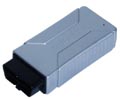- ACC Unexpected behavior
- |
- ACC system
- |
- BMW Electronic Systems
- |
- Technical Info
- |
- Car Tech Info
- |
- MicroTronik
ACC system Unexpected system behavior
A system situation that requires explaining may occur if the function limits of the system are reached in ACC mode. Such situations are described in the following:
1. Limited range and deceleration
On the one hand, the radar sensor has a limited range of 120 m while, on the other hand, the ACC system is provided a maximum deceleration of only 2.0 m/s2 by the DSC. The ACC can therefore automatically control only a limited relative speed. When the system has reached its functional limits, the driver is requested to assume control by the flashing (object detected) lamp.
2. Side field of vision
The leading vehicle may be lost when cornering due to the limited side field of vision. When cornering, the ACC vehicle is not accelerated to the required speed for approx. 2 s in order not to drive up too close to the leading vehicle which may not be detected only for a short time.
When driving straight ahead, the response of the ACC to a vehicle cutting in close may be delayed. The vehicle that cuts in is not detected before it is positioned in the same lane as the ACC vehicle.
3. Switching off
The system switches off if (blinded) by extremely thick snow cover. It can be reactivated after cleaning the radar sensor.
The system switches off in the event of prolonged control interventions by the ASC or DSC, i.e. at critical coefficients of friction. It can, however, be reactivated.
In both cases, after being reactivated the ACC resets the long following distance of 2 s.
4. Special situations
The driver recognizes such situations when the (object detected) lamp is not lit up but the vehicle remains below the required speed and does not accelerate.
· In tight corners, the vehicle reduces the speed such that, for comfort reasons, the maximum lateral acceleration is 3 m/s2. This applies both in open road and follow driving modes
· If there is a stationary object in the area directly in front of the driver and the speed has already been reduced for other reasons, the current speed will be maintained.
· Rain, fog and snow absorb the radar beams. The range can be reduced quite considerably and in extreme cases ACC can no longer be used.
· Brows of hills and depressions may obstruct detection, causing objects to be lost
· In very rare cases objects can be detected with incorrect measured values (mainly angles), e.g. by reflection of the radar waves on tunnel walls and crash barriers.
5. Lane prediction
Lane allocation is a central function in the ACC system. Object detection alone is not sufficient for the ACC to effectively interpret the situation. The detected objects must be brought into a relation with the intentions of the driver. Vehicles are then relevant to the control system when they are located in the same lane as the ACC vehicle.
In effect, the ACC does not have any predictive knowledge of the lane progression so that absolutely reliable object/lane allocation is not possible with the ACC. In addition to the limited field of vision, the reliable situation interpretation within restrictions is the most significant system limit of the ACC.
Lane prediction can therefore only be based on the current driving situation. Since the ACC cannot recognize the lane progression, it must depend on the current driving status.
ACC must calculate the future lane in advance in order to be able to select the correct object for the purpose of distance control. For the next 2 - 4 seconds, the driven radius of the bend is assumed to continue to be valid for the lane progression, an assumption that virtually always applies on freeways and on highways. The lateral deviation of every detected object with respect to the pre-calculated lane can be determined with the lane prediction facility. The following information is used for this estimate:
· Knowledge of the state of movement of the ACC vehicle (speed, yaw speed, steering angle, etc.). This information has the largest influence in determining the likely course of the lane.
· The joint lane movements of all stationary or driving objects are used to improve lane prediction. If the objects all move in the same direction (flock of birds for instance) the probability is then very high that a bend starts here. This procedure can only play a supportive role in lane prediction.
However, uncertainties in lane prediction and thus in object allocation should always be assumed, particularly in the transition from driving straight ahead to cornering.
The received radar signals cannot differentiate between living creatures, vehicles and road signs. Road signs or parked vehicles next to the driven lane may therefore be mistakenly allocated to your own lane. Stationary objects are therefore ignored to a large extent in order to avoid incorrect responses.
is one of the best Professional scan tools to for BMW; Autohex allows you to diagnose, code, program/flash ecus, and add new keys for BMW. For more information: BMW Scan Tool
Changing Dmaged DME in F Series


